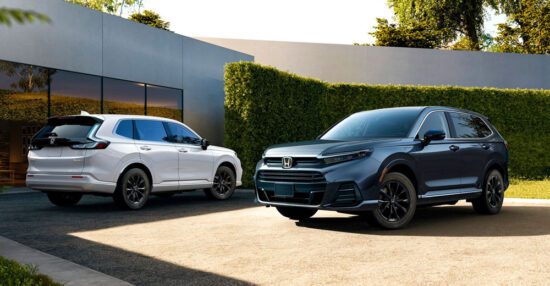The primary hydrogen gas cell client car for America was introduced Tuesday by Honda.
With a reputation that doesn’t fairly roll off the tongue, the CR-V e:FCEV combines a hydrogen gas cell system with plug-in charging functionality and has an EPA driving vary ranking of 270 miles.
Honda acknowledged the autos might be obtainable for buyer leasing in California beginning later this 12 months and expects preliminary gross sales of two,000 models yearly.
Co-developed with Basic Motors, Honda mentioned the CR-V e:FCEV’s new gas cell system, made in Michigan, provides improved sturdiness, larger effectivity, and decrease price in comparison with Honda’s previous-generation gas cell system.
The brand new car, produced in Ohio, features a 110-volt outlet that delivers 1,500 watts of juice for powering objects comparable to small residence home equipment, moveable air conditioners, energy instruments, and tenting gear.
Cutaway view of the 2025 Honda CR-V e:FCEV inside parts
Honda additionally acknowledged it has doubled the sturdiness of its gas cell system by making use of corrosion-resistant supplies and managed suppression of degradation, in addition to bettering the low-temperature efficiency of the system.
Infrastructure Problem
“It’s attention-grabbing to see Honda re-entering the market, having canceled its Readability in 2021 on account of poor gross sales. It exhibits there’s nonetheless definitely curiosity within the expertise,” mentioned Ramsy John, enterprise improvement supervisor at IDTechEx, a world market analysis agency.
“One of many principal obstacles to gas cell autos is the larger upfront price,” he informed TechNewsWorld. “The announcement doesn’t state an estimated worth for the car however does state they’ve managed to scale back the gas cell price by two-thirds in comparison with the earlier Readability, which may assist in seeing the associated fee develop into similar to a battery electrical car.”
“Nevertheless,” he continued, “given the vary is essentially just like many battery electrical automobiles immediately, and EV charging infrastructure is a lot extra broadly developed, it may nonetheless be a problem for gas cell automobiles to see market success.”
Fueling infrastructure has been a formidable barrier to the adoption of each gas cell and battery-electric autos (BEVs).
“Gas cells and EVs share the identical problem when it comes to an insufficient fueling infrastructure, however there are orders of magnitude extra EV charging factors than hydrogen stations,” mentioned Edward Sanchez, a senior analyst within the automotive apply at TechInsights, a world expertise intelligence firm.
He defined that there are an estimated 41,000 publicly accessible charging factors in California, in comparison with 55 hydrogen fueling stations within the state, a 3rd of that are in Los Angeles County alone. Nationally, he continued, there are roughly 140,000 public charging factors and 59 hydrogen fueling stations, nearly all of that are in California.
2025 Honda CR-V e:FCEV at a hydrogen refueling station
“Plus, the price of constructing out a hydrogen fueling infrastructure is far larger than putting in EV charging factors, and on a chemical/molecular stage, hydrogen is difficult to retailer and distribute,” Sanchez informed TechNewsWorld.
“The largest hurdle stays fueling infrastructure,” he mentioned. “That is additionally a difficulty with EVs, however the greatest distinction is EV charging stations may be arrange comparatively rapidly and at comparatively low price in comparison with hydrogen, which requires rather more costly {hardware} and infrastructure.”
“The autos themselves have confirmed dependable for essentially the most half,” he added. “Fueling infrastructure is hydrogen gas cells’ greatest Achilles’ heel.”
Not a Mass Market Merchandise
“Hydrogen-powered automobiles, whether or not gas cell or combustion, have by no means caught on within the mainstream, particularly within the U.S., largely on account of challenges with the fueling infrastructure, which has had main points in reliability and uptime,” Sanchez noticed.
Markets aren’t driving adoption in different international locations, both. “The Japanese OEMs’ curiosity in hydrogen has been largely pushed by incentives and encouragement by the Japanese authorities,” Sanchez mentioned.
“The CRV is probably going greatest seen as an indication that the tech works and to work out any kinks within the gas cell and associated ecosystem earlier than rather more costly platforms are requested to make use of it. A hydrogen-powered FCEV [fuel cell electric vehicle] heavy truck will price upwards of $800,000 earlier than subsidies,” added Robin Gaster, a non-resident senior fellow on the Info Know-how & Innovation Basis, a analysis and public coverage group in Washington, D.C.
“Preliminary gross sales at 2,000 don’t recommend any intention to make this a mass-market product, even when that is solely the first-year goal,” he informed TechNewsWorld.
John famous that battery electrical automobiles are deployed in a lot bigger numbers and are already changing into broadly accepted. He identified that in 2023, over 9.6 million battery electrical automobiles have been bought throughout China, Europe, and the U.S., 32% greater than the earlier 12 months. As compared, gross sales of gas cell automobiles have been solely round 8,500 globally, almost half of the 12 months earlier than.
“Hydrogen-powered car gross sales have collapsed in South Korea — two have been bought in January — regardless of large subsidies, and there’s no traction in California both,” contended Gaster.
“Bluntly,” he continued, “BEVs have zoomed previous hydrogen as the popular clear energy choice for mild autos. They are going to quickly be out of sight, and producers will change to heavy autos, the place hydrogen received’t win both, although the race is barely nearer.”
Carry on Truckin’
Gas cell methods could also be higher suited to heavier autos, particularly long-haul vehicles, maintained Sam Abuelsamid, principal analyst for e-mobility at Guidehouse Insights, a market intelligence firm in Detroit.
“The quantity of battery that you simply want for a long-haul truck is prohibitive due to the time it takes to cost it,” he informed TechNewsWorld. In contrast, the time to refuel a gas cell is on par with the time it takes to fill a fuel tank.
Lengthy-haul vehicles additionally journey fastened routes, enabling higher management of infrastructure prices.
“Customers wish to drive wherever they need and need infrastructure in all places,” Abuelsamid mentioned. “For long-haul trucking, you actually solely have to construct fueling stations alongside main routes so you possibly can have fewer hydrogen stations to help that use case.”
However even the heavy-truck window could also be closing quick on FCEVs. “The MCS [Megawatt Charging System] protocol in improvement with CharIN [Charging Interface Initiative] is aiming to carry the time to recharge to close parity with diesel or gas cells,” Sanchez mentioned.
“If this premise is confirmed in the true world, and enough heavy truck charging infrastructure may be constructed that might successfully cowl nationwide trucking routes, this might doubtlessly deal a deadly blow to hydrogen within the heavy truck market going ahead.”
2025 Honda CR-V e:FCEV Key Specs and Options
ENGINEERING(Honda Gas Cell Module)
Estimated Energy Output
92.2kW
ENGINEERING(Electrical Motor)
Peak Horsepower
174 hp
Peak Torque
229 lb.-ft.
BATTERY
Capability
17.7 kWh
FUEL
MPGe Rankings (Metropolis / Hwy / Mixed)
61 / 52 / 57
EV Vary (miles)
29
Driving Vary (miles)
270
Required Gas
Compressed Hydrogen Fuel
Gas Tank Strain
10,000 psi
Gas Tank Capability (kg)
4.3
WHEELS AND TIRES
Wheel Dimension
18-inch
Tire Dimension
235/60R18
EXTERIOR MEASUREMENTS
Wheelbase (in.)
106.3
Size (in.)
187.6
Top (in.)
66.6
Width (in.)
73.4
Observe (in., entrance/rear)
63.4 / 64.0
KEY FEATURES
Honda Sensing®
•
Superior Compatibility Engineering™ (ACE™) Physique Construction
•
10.3-inch Digital Instrument Show
•
9-Inch HD Touchscreen
•
Wi-fi Apple CarPlay®, Android Auto™ Compatibility
•
Heated Entrance Seats
•
Heated Steering Wheel
•
Wi-fi Telephone Charging (Qi)
•
Bose Premium Audio (12-speaker)
•
Driving Modes
Regular, Eco, Sport, Snow
(Supply: Honda)
Editor’s Word: The pictures featured on this article are credited to Honda.









